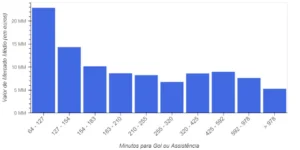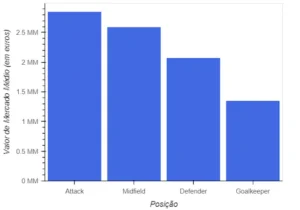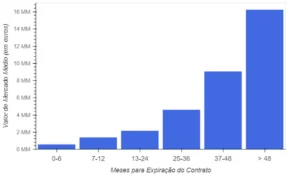What affects the market value of football players?

Written by :
Matthew Hanssen

Reviewed by :
Larissa Borges

In January 2022, the president of Toronto FC, a Canadian soccer club, surprised everyone by saying that he had signed one of the stars of the Italian national team, Lorenzo Insigne, after entering the famous soccer transfer portal, Transfermarkt .
And have you ever stopped to think that a football player is like a company asset and as such, there are also factors that influence his value and depreciate over time?
See also: How often does the best team win?
Using references such as Transfermarkt itself, in addition to the CIES Football Observatory and Football Benchmark, this study seeks to understand which factors shape a player’s market value based on more than 440 thousand market values from the last ten years of more than 30 thousand players.
Age
Age is one of the most relevant criteria when evaluating a player’s market. Young players are at the beginning of their professional careers , and have ample opportunity to develop and improve their skills.
Furthermore, a player’s youth suggests a longer career ahead, allowing the club to leverage their investment over a longer period.
Another important aspect is resale value . Young players, especially those who emerge as great prospects, tend to maintain or increase their market value over time.
This represents a financial opportunity for clubs, who can sell these players in the future.
However, players at the beginning of their careers generally have lower market values, even when they are already playing well. This is due to the uncertainty regarding their future.
In the graph below, we can see the relationship between age range and market value. Notice how the value has an upward trend up to the age range between 26 and 30 years , falling considerably after that.

Some players peak at a younger age, such as Neymar, who reached a value of €180 million at the age of 26.
Below, we can analyze the market value of some of the main players of the last decade throughout their careers.
Some players peak at a younger age, such as Neymar, who reached a value of 180 million euros at the age of 26 , while others have higher values when they are slightly more experienced, such as Lionel Messi and Cristiano Ronaldo , who are approaching 30 years old.

Performance
A football player’s performance, measured by indicators such as goals , assists and number of games played, is fundamental in determining his market value for several reasons.
These statistics provide a quantifiable measure of a player’s impact on the field.
Goals and assists are direct contributions to a team’s success , and players who excel in these aspects have been increasingly valued, including in the selection for best player in the world.
A proven track record of scoring goals or providing assists and regularly participating in games indicates a combination of technical ability and consistency.
Players who demonstrate these qualities are, of course, more likely to be sought after by elite clubs, which in turn increases their value on the market.
To illustrate the importance of this, we collected the goals, assists and total minutes played from the two years prior to each market valuation for each of the thousands of attacking players (midfielders and forwards) in our database.
Once this is done, we only consider players with at least 30 matches in the period and calculate the time, in minutes, that a player takes to score a goal or provide an assist.
Below, we can clearly see that the players who need the least time to make a difference on the scoreboard are also those with the highest market value.

Acting league
The market value of a football player is also greatly influenced by the league in which he plays.
Players who play in high-profile leagues such as the Premier League in England, La Liga in Spain, the Bundesliga in Germany and Serie A in Italy are constantly competing at a high level, facing some of the best talent in the world.
This intense competition not only hones your skills but also increases your global visibility due to the extensive media coverage these leagues receive.
Participation in prestigious European competitions, such as the UEFA Champions League , also provides an additional opportunity for players to increase their market value.
Furthermore, clubs in these major leagues tend to have greater financial stability, which allows them to invest more in player transfers.
This financial power increases the market value of players in these leagues, as there is a greater willingness and ability to pay for great players.
From the data of some European leagues, we can clearly see a higher average market value in the top-5 compared to the rest:

Position
A player’s position on the pitch has a huge impact on their market value, reflecting the importance and visibility of different roles within the game.
Offensive players, such as forwards and attacking midfielders, tend to have higher market values. This is due to their direct role in the main objective of the game: scoring goals.
The ability to regularly score goals or provide assists has become a commodity in the world of football, and players who demonstrate these qualities are often seen as valuable assets.
On the other hand, despite the importance of defenders in the game, their contributions are not as visible or quantifiable as goals and assists. We can say that an efficient defense is less “glamorous”.
So, even though top-level defenders are crucial to a team’s success, they tend to have lower market values compared to forwards.
Goalkeepers, occupying a unique and specialized position, are essential to any team. However, the market for goalkeepers is different, with both supply and demand influencing their values.
Teams need fewer goalkeepers than outfield players, which can impact their market value.

Contract duration
The remaining contract period of a football player has a significant influence on his market value due to reasons linked to the club’s control over the player and negotiation expectations.
When a player has a long contract with his current club, it means that the club has greater control over his future.
If another club wants to acquire this player, they will have to negotiate directly with the club, which is in a strong position to demand a higher price.
This is due to the fact that the club is not in a hurry to sell, and can keep the player for several years.
Thus, a long contract can increase the player’s market value, as it gives the club greater leverage in negotiations.
On the other hand, if a player’s contract is close to ending, the situation is reversed. The club risks losing the player for free once the contract expires.
This puts pressure on the club to sell the player before the end of the contract, especially if the player has no interest in renewing.
In this scenario, interested clubs may negotiate a lower price , knowing that the selling club may be willing to accept a lower offer to avoid completely losing the player without any financial compensation.
In short, the time remaining on a player’s contract is a critical factor in determining his market value.
Longer contracts tend to increase market value as they give the club greater control and negotiating power, while shorter contracts can reduce market value due to decreased club control and increased player autonomy.

Other factors
But market value is not limited to just these factors.
Several other issues are also taken into consideration.
- Frequent or serious injuries can reduce a player’s market value, as they cast doubt on his ability to play consistently. When a player is injury-prone, interested clubs may be more cautious, fearing that he will not be able to contribute effectively due to frequent periods of absence. Furthermore, serious injuries can impact a player’s long-term performance, which is a risk for any club considering a major investment.
- Player marketing can help increase their market value. Players with a strong personal brand, who are popular and have a large social media reach can generate increased revenue for clubs through shirt sales and sponsorship.
- Market demand is another important factor, as a player’s value can be adjusted by the amount of interest he generates among clubs. If multiple clubs are competing to sign a player, this naturally increases his market value.
- A high salary can be a deterrent, as it entails a greater financial cost for the purchasing club. Clubs may be hesitant to invest in a high-paid player unless they are convinced that he will provide a commensurate return on investment.
- Furthermore, the player’s interests also influence his market value. If a player expresses a desire to leave his current club or move to a specific league, this can affect the negotiation dynamics, reducing the price that clubs are willing to pay.
Transfermarkt also makes it clear on its website that the community’s perception and the general value attributed to players by the public and the media also have a great influence, even creating polls that the public itself votes on to adjust the value of players.
